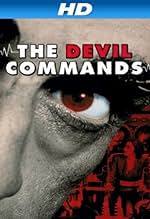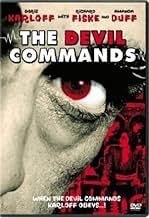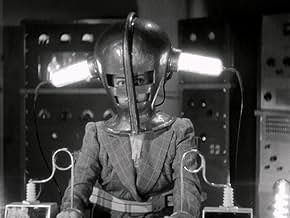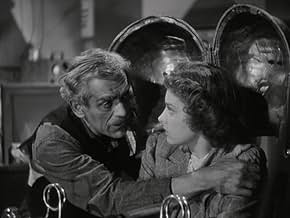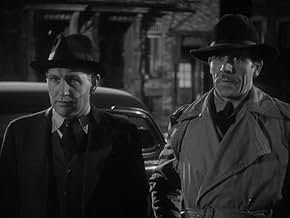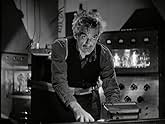AVALIAÇÃO DA IMDb
6,1/10
1,6 mil
SUA AVALIAÇÃO
Adicionar um enredo no seu idiomaScientist becomes obsessed with the idea of communicating with his dead wife.Scientist becomes obsessed with the idea of communicating with his dead wife.Scientist becomes obsessed with the idea of communicating with his dead wife.
- Direção
- Roteiristas
- Artistas
Ernie Adams
- Elam
- (não creditado)
Lester Allen
- Dr. Van Den
- (não creditado)
Wheaton Chambers
- Dr. Sanders
- (não creditado)
Earl Crawford
- Johnson
- (não creditado)
Harrison Greene
- Mr. Booth, Bakery Proprietor
- (não creditado)
Erwin Kalser
- Professor Kent
- (não creditado)
Eddie Kane
- Professor Walt
- (não creditado)
George McKay
- Station Agent
- (não creditado)
Al Rhein
- Truck Driver
- (não creditado)
- Direção
- Roteiristas
- Elenco e equipe completos
- Produção, bilheteria e muito mais no IMDbPro
Avaliações em destaque
Corny and cliche'd as The Devil Commands may look to the superficial gaze, it's a powerful expression of the inextinguishable and far from trivial human wish to believe that death is not the end and that the dead we loved are not forever lost to us. Karloff starred in a whole sub-genre of films on this theme from the middle 1930s to the early 1940s (cf The Invisible Ray, Before I Hang, The Man They Could Not Hang, etc), invariably as a misunderstood scientific genius, embittered by tragedy or injustice, whose desire to conquer death clashes fatally with the prerogatives of the Almighty.
Whether one believes in an afterlife or not, it would be a coarsely reductionist mind that could consider the subject ridiculous. What gives these films (and this one in particular) their eerily modernist slant on the matter lies in the way they reflect the public's awe of science in the first half of the twentieth century, when astonishing developments such as radio and television (and that weird form of immortality, the motion picture), made it seem believable that technology might solve the supernatural as well as the physical mysteries. It is worth remembering in this context that the contemporary electrical wizards Thomas Edison and Nikola Tesla, classical Mad Scientists both, attempted to build machines with which to talk to the dead.
In this morbidly obsessive cinematic byway The Devil Commands stands out as one of the most insidiously poignant and nearly blasphemous films of its kind, sailing very close to the emotional and spiritual wind in its depiction of Karloff's bizarre attempts to communicate with his dead wife. As a mad-scientist entertainment it contains some of the most magnificently deranged laboratory scenes ever filmed, surpassed in this context only by James Whale's Frankenstein and Bride Of Frankenstein. I still succumb to its mournful fascination. And if your first viewing doesn't scare you half to death, you can't be more than half alive.
Whether one believes in an afterlife or not, it would be a coarsely reductionist mind that could consider the subject ridiculous. What gives these films (and this one in particular) their eerily modernist slant on the matter lies in the way they reflect the public's awe of science in the first half of the twentieth century, when astonishing developments such as radio and television (and that weird form of immortality, the motion picture), made it seem believable that technology might solve the supernatural as well as the physical mysteries. It is worth remembering in this context that the contemporary electrical wizards Thomas Edison and Nikola Tesla, classical Mad Scientists both, attempted to build machines with which to talk to the dead.
In this morbidly obsessive cinematic byway The Devil Commands stands out as one of the most insidiously poignant and nearly blasphemous films of its kind, sailing very close to the emotional and spiritual wind in its depiction of Karloff's bizarre attempts to communicate with his dead wife. As a mad-scientist entertainment it contains some of the most magnificently deranged laboratory scenes ever filmed, surpassed in this context only by James Whale's Frankenstein and Bride Of Frankenstein. I still succumb to its mournful fascination. And if your first viewing doesn't scare you half to death, you can't be more than half alive.
At last, Karloff has met his match. One glance from the steely-eyed Ann Revere (Mrs. Walters) is enough to freeze even Frankenstein. She doesn't need make-up—she's scary enough just walking onto the set. I'd love to see a stare-down between her and an icy Bette Davis. Anyway, the movie is occasionally atmospheric, especially the cliff house scenes. The plot doesn't make much sense—I guess that's why we get the voice-over narration. It's something about getting brain waves from the dead and turning them into talk. Apparently, that requires that Dr. Blair (Karloff) assemble a junk pile in his laboratory. On special occasions, the metal heaps sit around a table in diving helmets and sort of rock out on brain waves. Then there's the live person who puts on a helmet and sticks neon tubes in her ears. Apparently, that triggers an indoor wind, and then wispy ghost-like things appear. The wind doesn't bother them, but it sure musses-up Karloff's hair. It's one wild and crazy lab scene.
The cast and crew are an interesting bunch. Director Dmytryk was one of the blacklisted Hollywood Ten, who then decided to sing to the House committee, and so, went back to work. On the other hand, Revere never did sing and stayed blacklisted for a decade or so. There's also young Robert Fiske who plays Dr. Sayles. He has the distinction of being one of a handful of movie actors killed in action during WWII— don't they deserve some kind of Hollywood memorial. And between Dorothy Adams (Mrs. Marcy) and the equally familiar Ellen Corby, housekeeper roles stayed monopolized in Hollywood for about twenty years. Nothing special in this 50 or-so minutes, except for the goofy lab scenes. But something should be said for the great Karloff. Even in this routine programmer, he gives it his all, a spirited performance that almost makes the hocus-pocus believable. I hope there's a place in Hollywood heaven for great old pro's like him.
The cast and crew are an interesting bunch. Director Dmytryk was one of the blacklisted Hollywood Ten, who then decided to sing to the House committee, and so, went back to work. On the other hand, Revere never did sing and stayed blacklisted for a decade or so. There's also young Robert Fiske who plays Dr. Sayles. He has the distinction of being one of a handful of movie actors killed in action during WWII— don't they deserve some kind of Hollywood memorial. And between Dorothy Adams (Mrs. Marcy) and the equally familiar Ellen Corby, housekeeper roles stayed monopolized in Hollywood for about twenty years. Nothing special in this 50 or-so minutes, except for the goofy lab scenes. But something should be said for the great Karloff. Even in this routine programmer, he gives it his all, a spirited performance that almost makes the hocus-pocus believable. I hope there's a place in Hollywood heaven for great old pro's like him.
Though the science involved in what Boris Karloff is trying to do is very flawed, in The Devil Commands Karloff gives a very good performance as a man obsessed with contacting his late wife. Unfortunately he falls into the clutches of a fake medium played by Anne Revere who takes advantage of him.
The first few minutes of the film show a happy well adjusted Karloff married to Shirley Warde with daughter Amanda Duff also getting ready to marry scientist Richard Fiske. After a car accident where Warde dies in his arms, Karloff goes off the deep end as he becomes obsessed with the idea that Warde is trying to communicate with him via electrical impulses. His efforts to combine science and the occult lead him to Revere and ultimately to tragedy.
The electrical devices in his laboratory have the familiar Frankenstein like look about them, no doubt Edward Dmytryk in one of his early directorial efforts was trying to capture the mood of the Frankenstein films from Universal. Though the rest of the cast is pretty bland, Karloff and Revere play well off each other and carry the film.
One exception to the blandness is that of Dorothy Adams whom I recognized immediately as Bessie the maid from Laura. Her part here is similar to that one and her acting has some real bite to it.
The Devil Commands is from Columbia's B unit and it's not invested with a lot of production values. Still it's a good horror film from the master himself.
The first few minutes of the film show a happy well adjusted Karloff married to Shirley Warde with daughter Amanda Duff also getting ready to marry scientist Richard Fiske. After a car accident where Warde dies in his arms, Karloff goes off the deep end as he becomes obsessed with the idea that Warde is trying to communicate with him via electrical impulses. His efforts to combine science and the occult lead him to Revere and ultimately to tragedy.
The electrical devices in his laboratory have the familiar Frankenstein like look about them, no doubt Edward Dmytryk in one of his early directorial efforts was trying to capture the mood of the Frankenstein films from Universal. Though the rest of the cast is pretty bland, Karloff and Revere play well off each other and carry the film.
One exception to the blandness is that of Dorothy Adams whom I recognized immediately as Bessie the maid from Laura. Her part here is similar to that one and her acting has some real bite to it.
The Devil Commands is from Columbia's B unit and it's not invested with a lot of production values. Still it's a good horror film from the master himself.
One of several "Mad Doctor" films Boris Karloff made for Columbia Pictures in the '40s and often considered one of the best of that group by many fans. It's not bad, but it's only a notch above average in my estimation. Here we have Karloff as a scientist who has discovered a device for reading people's brain waves and then becomes obsessed with the idea of trying to communicate with his recently deceased wife. He enlists the aid of a somewhat eccentric phony mystic (Anne Revere) who becomes the dominant force in the partnership and sets the course for some potentially disastrous events.
This movie was directed by Edward Dmytryk, so at least it enjoys some spirited dashes of mood and dreary lighting, which is one thing that elevates it just over the line of the ordinary. It's interesting to see long-time Three Stooges foil Kenneth MacDonald as a sheriff who suspects that strange goings-on are underfoot in Boris' mysterious house, and Anne Revere's stoic and power-hungry medium is an added benefit. Still, there's something which seems to be lacking here to keep this one from rising above "B" level. Karloff is quite good as the eager but harried scientist, emitting a range of different emotions during the course of the picture. **1/2 out of ****
This movie was directed by Edward Dmytryk, so at least it enjoys some spirited dashes of mood and dreary lighting, which is one thing that elevates it just over the line of the ordinary. It's interesting to see long-time Three Stooges foil Kenneth MacDonald as a sheriff who suspects that strange goings-on are underfoot in Boris' mysterious house, and Anne Revere's stoic and power-hungry medium is an added benefit. Still, there's something which seems to be lacking here to keep this one from rising above "B" level. Karloff is quite good as the eager but harried scientist, emitting a range of different emotions during the course of the picture. **1/2 out of ****
BORIS KARLOFF is a scientist who wants to communicate with the brain waves of his dead wife. His daughter narrates the tale and concludes with: "It is dangerous to communicate with the dead." That's about the impression the viewer gets after seeing what happens in the course of a brisk one hour and six minutes.
Columbia produced this low-budget feature and gave the directing chores to Edward Dmytryk, who would later go on to bigger and better things at RKO. But it's an efficient thriller thanks to his direction and the low-key, shadowy photography that makes the absurd story at least come to life on occasion.
Enjoyable too are the performances of ANN REVERE as a sinister housekeeper who knows all about Karloff's experiments and what goes on behind the locked doors of his laboratory; DOROTHY ADAMS as an inquisitive servant who agrees to check out the lab and gets locked inside; and KENNETH MacDONALD as the Sheriff determined to find out who is responsible for all the missing bodies from the graveyard.
It's typical Karloff stuff and he lends his commanding presence to the role with more dignity than it deserves. If it emerges as a better than average horror vehicle, it's because director Dmytryk is at the helm, but the script is absurd. The low-budget production values are neatly hidden by all the shadowy photography.
Columbia produced this low-budget feature and gave the directing chores to Edward Dmytryk, who would later go on to bigger and better things at RKO. But it's an efficient thriller thanks to his direction and the low-key, shadowy photography that makes the absurd story at least come to life on occasion.
Enjoyable too are the performances of ANN REVERE as a sinister housekeeper who knows all about Karloff's experiments and what goes on behind the locked doors of his laboratory; DOROTHY ADAMS as an inquisitive servant who agrees to check out the lab and gets locked inside; and KENNETH MacDONALD as the Sheriff determined to find out who is responsible for all the missing bodies from the graveyard.
It's typical Karloff stuff and he lends his commanding presence to the role with more dignity than it deserves. If it emerges as a better than average horror vehicle, it's because director Dmytryk is at the helm, but the script is absurd. The low-budget production values are neatly hidden by all the shadowy photography.
Você sabia?
- CuriosidadesCompleted December 1940, released February 3, 1941.
- Erros de gravaçãoDr. Julian tells Mrs. Walters she had 10,000 volts pass through her body. Volts do not flow or pass, amps do.
- Citações
Dr. Julian Blair: Anne dear, your mother is not dead, not really. She's come back to me!
- ConexõesFeatured in Hollywood and the Stars: Monsters We've Known and Loved (1964)
Principais escolhas
Faça login para avaliar e ver a lista de recomendações personalizadas
- How long is The Devil Commands?Fornecido pela Alexa
Detalhes
- Tempo de duração1 hora 5 minutos
- Cor
- Proporção
- 1.37 : 1
Contribua para esta página
Sugerir uma alteração ou adicionar conteúdo ausente

Principal brecha
By what name was Os Mortos Falam (1941) officially released in India in English?
Responda

